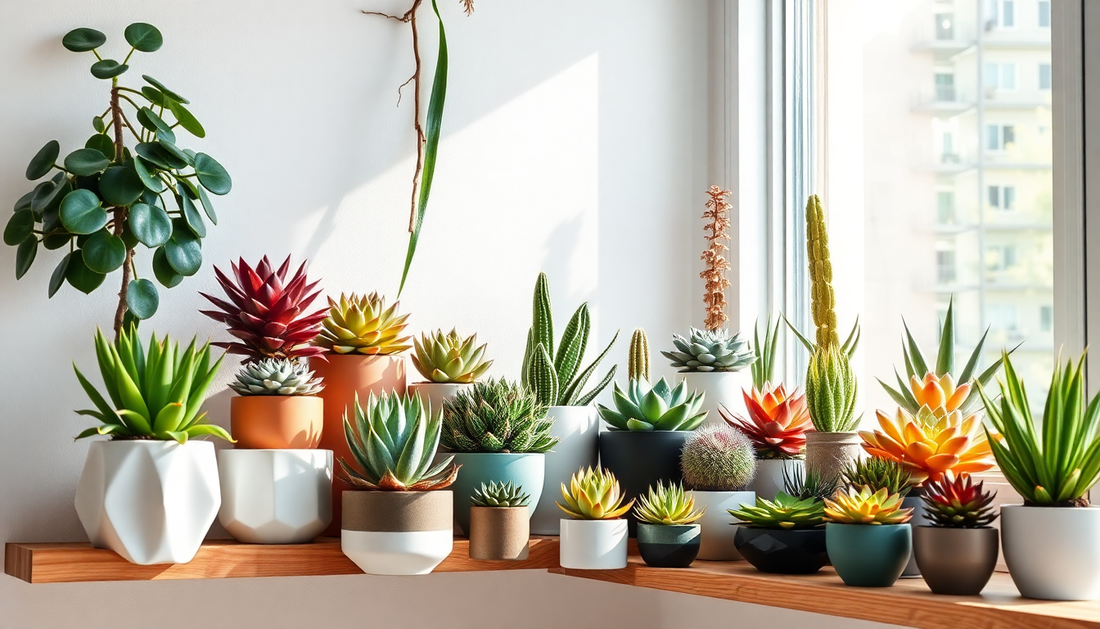
The Ultimate Guide to Caring for Indoor Succulents
Share
Succulents have become increasingly popular in recent years, and for good reason. These hardy, low-maintenance plants are not only visually stunning, but they also thrive in a variety of indoor environments. Whether you're a seasoned plant parent or a beginner, caring for indoor succulents can be a rewarding and enjoyable experience.
In this comprehensive guide, we'll delve into the world of indoor succulents, exploring their unique characteristics, the best varieties for indoor cultivation, and the essential steps to ensure their long-term health and vibrance. By the end of this article, you'll be equipped with the knowledge and confidence to cultivate a thriving indoor succulent garden.
Understanding Succulents
Succulents are a diverse group of plants that are characterized by their thick, fleshy leaves or stems, which store water to help them survive in dry, arid conditions. These plants have evolved to thrive in environments with limited water availability, making them an ideal choice for indoor gardening.
One of the key advantages of succulents is their resilience. They can tolerate a wide range of growing conditions, from bright, direct sunlight to low-light environments. This makes them a versatile option for homeowners and apartment dwellers who may not have access to an abundance of natural light.
Succulent Varieties for Indoor Cultivation
When it comes to indoor succulents, there are several varieties that stand out as particularly well-suited for this environment. Some of the most popular and easy-to-care-for indoor succulents include:
- Echeveria: These rosette-forming succulents come in a variety of colors, from vibrant greens to stunning shades of pink and purple.
- Jade Plant (Crassula): Known for their thick, woody stems and rounded leaves, jade plants are a classic choice for indoor gardens.
- Haworthia: These small, compact succulents feature intricate patterns and textures, making them a visually interesting addition to any indoor space.
- Zebra Plant (Haworthiopsis): With their distinctive striped leaves, zebra plants add a unique touch to any succulent collection.
- Aloe Vera: In addition to their aesthetic appeal, aloe vera plants are also known for their medicinal properties, making them a practical choice for indoor gardening.
Caring for Indoor Succulents
Proper care is essential for the long-term health and vibrancy of your indoor succulents. Here are the key factors to consider:
Lighting Requirements
Succulents thrive in bright, direct sunlight. When growing them indoors, aim to place them in a south-facing or west-facing window that receives at least 6 hours of direct sunlight per day. If your indoor space doesn't receive enough natural light, consider supplementing with a grow light to ensure your succulents get the light they need.
Watering Needs
Overwatering is one of the most common issues when it comes to indoor succulents. These plants are adapted to survive in dry conditions and can quickly succumb to root rot if they're watered too frequently. As a general rule, allow the soil to dry out completely between waterings, and be mindful of the changing seasons and their impact on your plants' water needs.
Soil and Potting
Succulents require well-draining soil to thrive. A potting mix specifically formulated for cacti and succulents is an excellent choice, as it will provide the necessary drainage and aeration for your plants. When potting or repotting, be sure to use a container with ample drainage holes to prevent waterlogging.
Temperature and Humidity
Succulents prefer a warm, dry environment. Aim to maintain a temperature range of 65-85°F (18-29°C) for your indoor succulents. Avoid placing them in areas with significant temperature fluctuations, such as near air conditioning vents or heating sources. Additionally, maintain low humidity levels, as high humidity can lead to fungal issues.
Fertilizing
Succulents have relatively low nutrient requirements compared to other houseplants. A balanced, water-soluble fertilizer diluted to half-strength can be applied every 2-3 months during the growing season (spring and summer) to provide a gentle boost of nutrients. Avoid over-fertilizing, as this can lead to excessive growth and potential problems.
Pruning and Propagation
Regularly pruning your indoor succulents can help maintain their compact, attractive shape and encourage new growth. Remove any dead or damaged leaves or stems, and consider propagating your succulents by taking cuttings to create new plants.
Troubleshooting Common Issues
Even with the best care, your indoor succulents may occasionally encounter challenges. Here are some common issues and how to address them:
Etiolation (Stretching)
If your succulents start to stretch and become leggy, it's a sign that they're not receiving enough light. Move them to a brighter location or supplement with a grow light to prevent this issue.
Leaf Discoloration
Discolored or shriveled leaves can indicate a problem with watering, either too much or too little. Adjust your watering schedule accordingly and monitor the soil moisture levels.
Pests
Succulents can be susceptible to pests such as mealybugs, scale insects, and spider mites. Regularly inspect your plants and address any infestations promptly with an appropriate insecticidal soap or neem oil.
Rot
Overwatering can lead to root rot, which can be challenging to reverse. If you notice signs of rot, such as mushy, discolored roots or stems, act quickly to remove the affected parts and adjust your watering practices.
By understanding the unique needs of indoor succulents and addressing any issues that arise, you can create a thriving, low-maintenance indoor garden that brings beauty and tranquility to your living space.
Conclusion
Caring for indoor succulents is a rewarding and enjoyable experience that can add a touch of natural beauty to your home. By following the guidelines outlined in this comprehensive guide, you'll be well on your way to cultivating a thriving indoor succulent collection that will bring you joy for years to come. Remember to stay attuned to your plants' needs, adjust your care routine as necessary, and don't be afraid to experiment to find the perfect balance for your indoor growing environment.
Happy planting!

